The legacy of Roman engineers stands as a cornerstone in the history of ancient engineering. Their innovations laid the groundwork for modern infrastructure, shaping cities and empires through groundbreaking techniques and materials. Roman innovations such as durable concrete, extensive road networks, aqueducts, and monumental buildings demonstrate their mastery over construction and design.
Roman engineers were more than builders; they were visionaries who transformed landscapes and improved daily life. Their work enabled efficient trade, military conquest, urban sanitation, and architectural marvels that have endured for millennia.
This article shines a light on The Unsung Heroes: Roman Engineers Who Changed the World. These individuals often remain in the shadows despite their profound impact on engineering principles still used today. Understanding their contributions gives you a deeper appreciation of how ancient engineering shaped the foundation of our modern world.
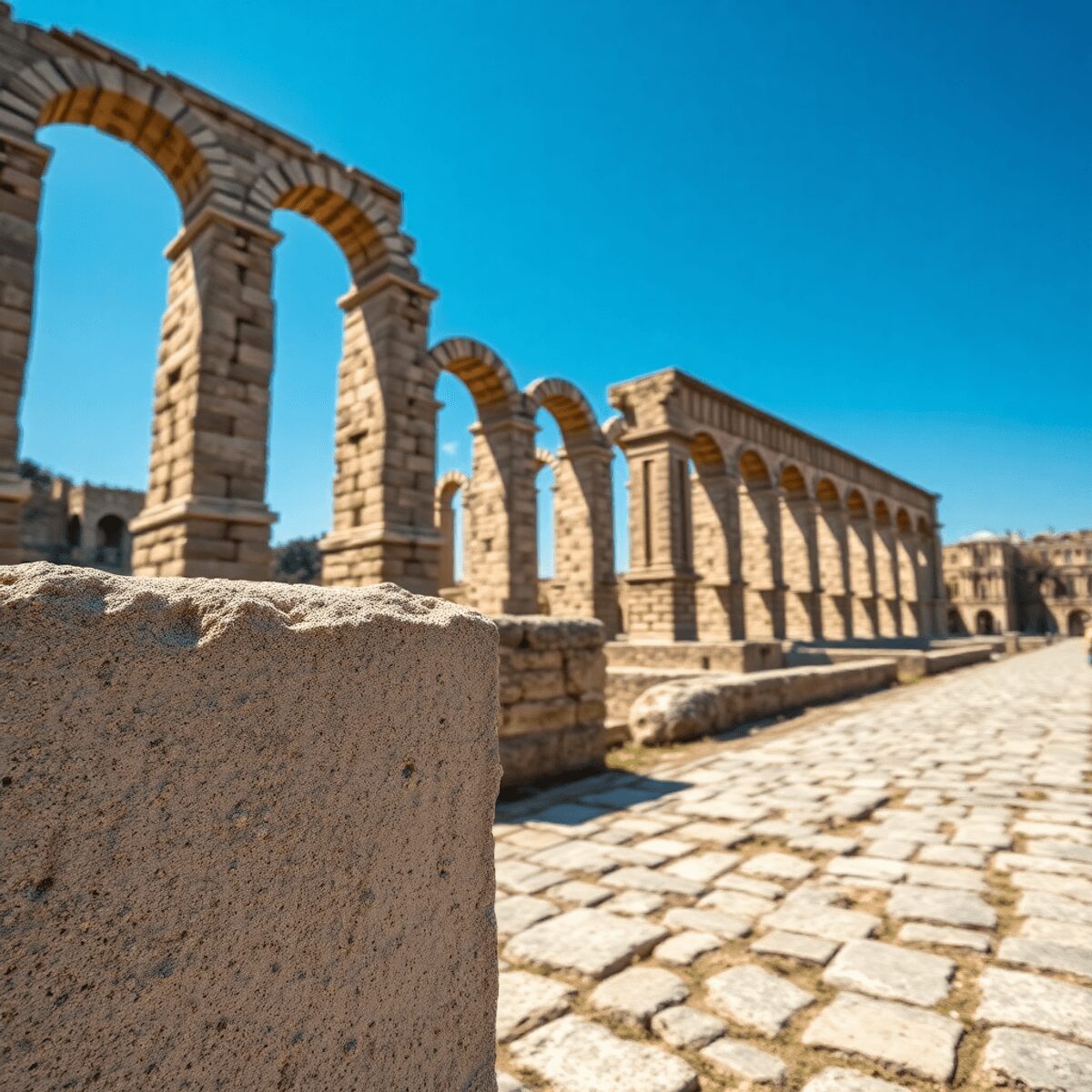
The Foundations of Roman Engineering Excellence
The Innovation of Roman Concrete
Roman concrete, known as opus caementicium, stands as one of the greatest innovations in ancient construction technology. Unlike modern concrete, it incorporated a unique blend of volcanic ash (pozzolana), lime, and water, creating a chemical reaction that made the material not only strong but also resistant to cracking over time. This composition was key to the exceptional durability of Roman structures.
The Secret Behind Roman Longevity
The secret behind the longevity of Roman materials lies in their ability to harden underwater and resist environmental degradation. This hydraulic property enabled the Romans to build harbors, aqueducts, and bridges that could withstand harsh weather and water exposure for centuries. Many such constructions remain intact today, highlighting the effectiveness of these durable materials.
A Revolutionary Advancement: Hydraulic Cement
Hydraulic cement was a revolutionary advancement. It allowed Romans to create waterproof mortar essential for underwater foundations and massive vaulted ceilings. Applications ranged from the deep foundations of monumental buildings like the Pantheon to vital infrastructure such as bathhouses and sewer systems. This innovation transformed architectural possibilities by combining strength with versatility.
Key attributes of opus caementicium:
- Resistance to cracking and erosion
- Ability to set underwater
- Longevity unmatched by other ancient building materials
Roman engineers’ mastery over materials laid the groundwork for constructing infrastructure that has literally stood the test of time, influencing engineering standards far beyond antiquity.
Broader Impacts on Roman Society
The advancements in engineering were not isolated from other aspects of Roman life. They played a crucial role in supporting agriculture, which was a significant driver of Rome’s economic growth. The construction of aqueducts facilitated irrigation, while durable roads improved trade routes, linking farms to markets.
Moreover, these engineering feats were often underpinned by a robust legal framework such as the Twelve Tables, which standardized legal practices across Rome. This codification of laws not only brought about uniformity but also stability, fostering an environment conducive to economic growth and development.
In addition to these practical aspects, Roman engineering also had profound effects on their religious practices. Temples built with enduring materials became central places for worship, intertwining religion with architecture.
Lastly, it’s important not to overlook the social dynamics within Rome during this period. The plebeians, who constituted the majority of the population, played a vital role in both the labor force that constructed these enduring structures and as consumers benefiting from increased agricultural output and trade efficiency resulting from these engineering advancements.
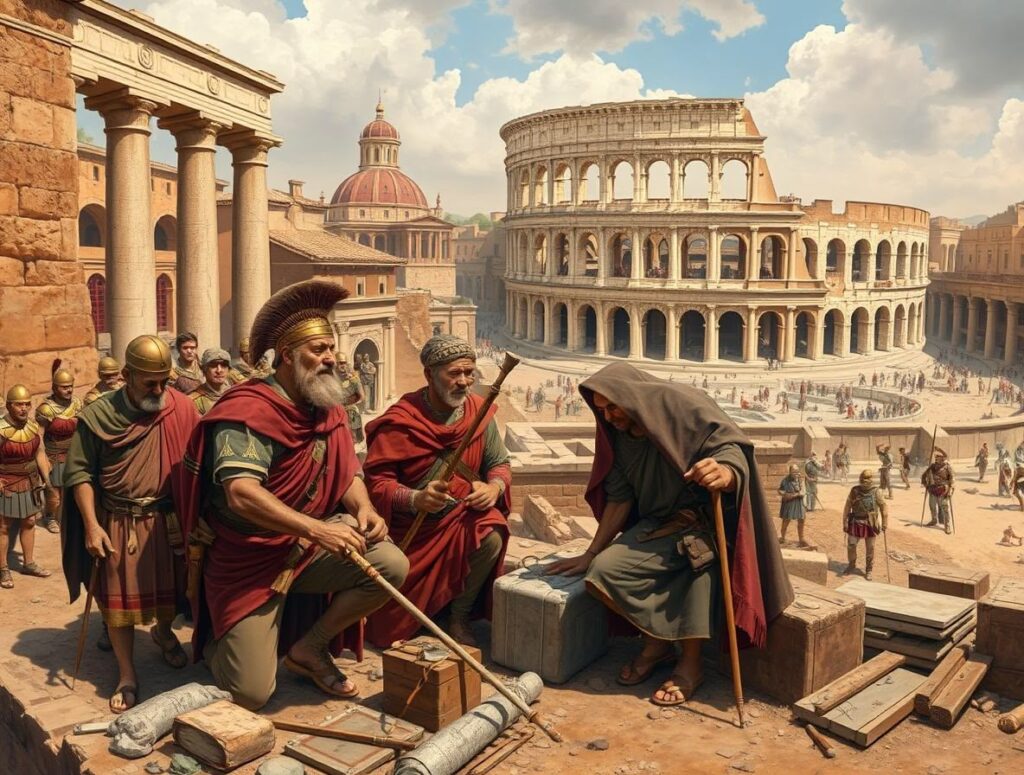
Revolutionary Infrastructure: Roads and Bridges
The Roman roads are a remarkable example of precise and long-lasting engineering. They were built using a multi-layered technique that was specifically designed to handle heavy traffic and withstand the challenges posed by nature:
- Statumen: The bottom layer of large stones provided a firm foundation.
- Rudus: A middle layer of smaller stones mixed with lime created stability.
- Nucleus: Fine concrete or gravel formed the top base for the surface.
- Summa Crusta: The final layer consisted of tightly fitted paving stones, creating a smooth and durable road surface.
This careful layering not only ensured longevity but also offered flood resistance, which was crucial in the different climates throughout the empire.
These roads played a crucial role in connecting the empire, allowing for quick movement of troops, trade, and communication over long distances. The famous saying “All roads lead to Rome” reflects their central importance in bringing together various regions economically and administratively.
Bridges: A Testament to Roman Engineering
Bridges displayed Roman architectural ingenuity, particularly through the widespread use of arches. Arches efficiently distributed weight, enabling bridges to span larger gaps without collapsing under pressure. This design combined strength with beauty, evident in enduring examples like the Pont du Gard aqueduct bridge.
The skillful use of arches extended beyond bridges into buildings and aqueducts, but their implementation in bridge construction transformed infrastructure by facilitating dependable river crossings that benefited both commerce and military logistics.
Interestingly, while exploring these ancient infrastructures, one might find themselves immersed in role-playing games that recreate such historical settings, like Second Life, where players can experience life in ancient Rome. Additionally, the artistic expressions from this era, heavily influenced by earlier Greek and Etruscan traditions, are well-documented in various resources detailing art and culture in ancient Rome. Furthermore, understanding the socio-economic dynamics of the time could provide deeper insights into the lives of different classes such as the patricians, who were the wealthy elite of ancient Rome.
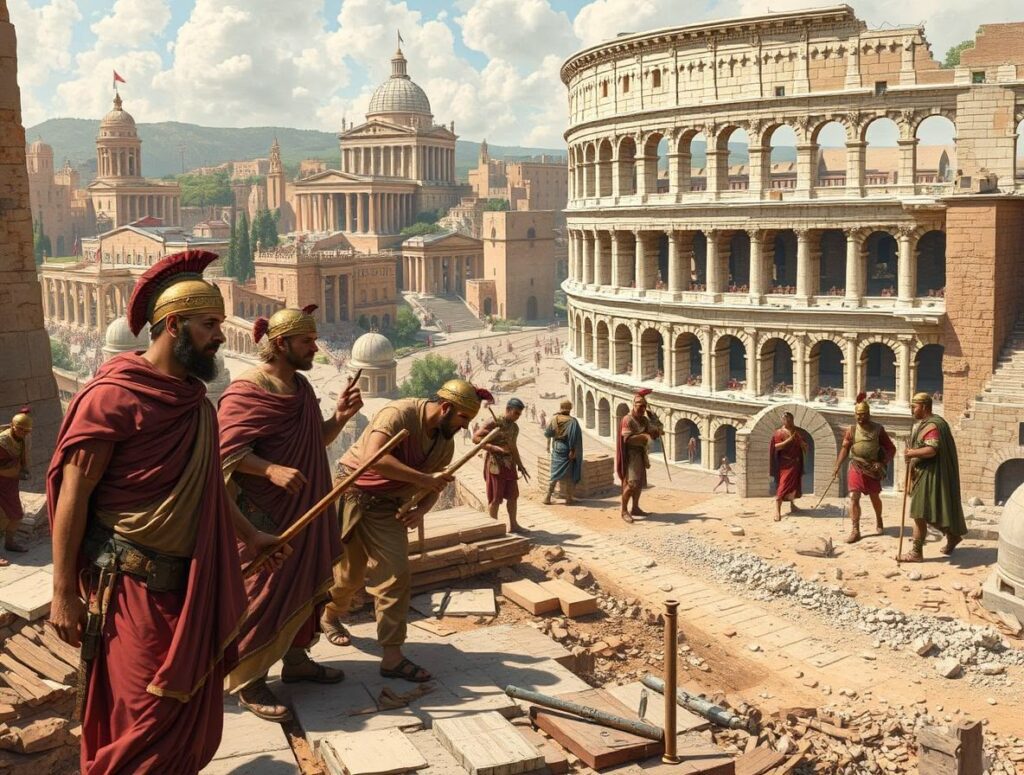
Mastery Over Water: Aqueducts and Hydraulic Systems
Roman aqueducts are a testament to the ingenuity of Roman engineers. These water supply systems relied on precise engineering to transport fresh water over long distances using gravity-fed water transport. Aqueducts combined tunnels, bridges, and channels to maintain a steady, gentle slope that allowed water to flow smoothly into cities.
Key features of Roman aqueduct design include:
- Careful gradient control ensuring consistent water flow without pumps
- Use of arches to span valleys while maintaining the required slope
- Construction with waterproof hydraulic cement lining channels to prevent leaks
Some aqueducts remain functional today, such as parts of Rome’s Aqua Virgo, still feeding fountains over two millennia later. This longevity highlights the Romans’ mastery in materials and structural design.
Water wheels represent another innovative application of hydraulic engineering. Integrated into mills and mining operations, these wheels converted flowing water energy into mechanical power. They powered flourmills, sawmills, and even machinery for ore processing in mines. This use of hydropower significantly increased productivity and showcased Roman engineers’ ability to harness natural resources beyond simple water transport.
The combination of aqueduct systems and hydraulic machinery illustrates a comprehensive command over water management that fueled urban life, industry, and economic expansion throughout the empire.
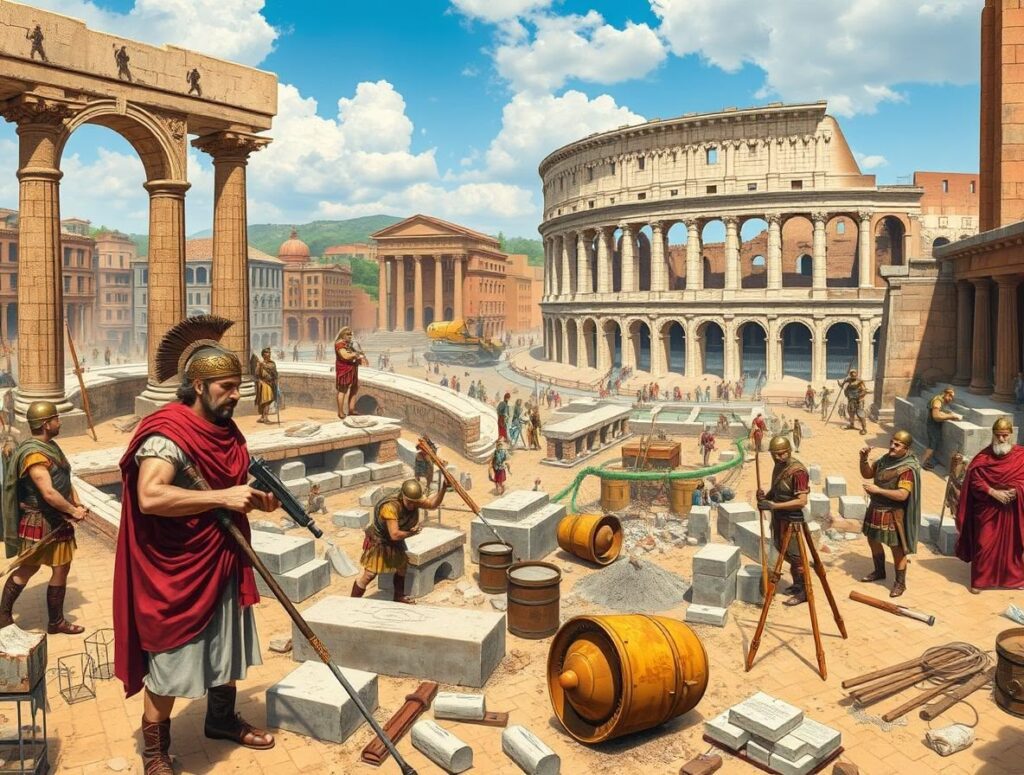
Military Engineering Innovations
Roman military engineering was crucial for the empire’s expansion and defense. Engineers designed and built strong and efficient fortifications like walls, towers, and ramparts that were suited to different landscapes. Temporary military camps (castra) had standard layouts, making it quick to set them up and giving soldiers safe places to stay during battles.
Julius Caesar’s Rhine River Bridge: A Testament to Roman Ingenuity
One outstanding example of Roman cleverness is Julius Caesar’s Rhine River bridge. Constructed in just ten days, this wooden structure showcased an unprecedented speed and accuracy in engineering. It enabled quick troop movements across a significant natural obstacle, demonstrating how construction methods directly supported strategic military goals.
Advanced Siege Equipment: Combining Mechanics with Battlefield Needs
Roman engineers also created advanced siege equipment, including ballistae and battering rams, which merged mechanical principles with the requirements of battle. These machines enhanced the army’s ability to effectively break through enemy defenses.
Enhancing Mobility through Engineering Innovations
Engineering innovations improved mobility by allowing for the swift movement of troops and supplies. Roads specifically built for military purposes connected forts and made communication easier. The combination of engineering with warfare changed the way battles were fought — factors like mobility, strength of fortifications, and siege abilities became crucial elements influenced by technical skill.
This combination of construction expertise and tactical use emphasizes the often-overlooked contribution of Roman engineers in establishing imperial power through practical solutions on the battlefield. Such military strength not only shaped the lands of the empire but also impacted various aspects of ancient Roman life, leaving a lasting legacy that continues to be studied and admired today.
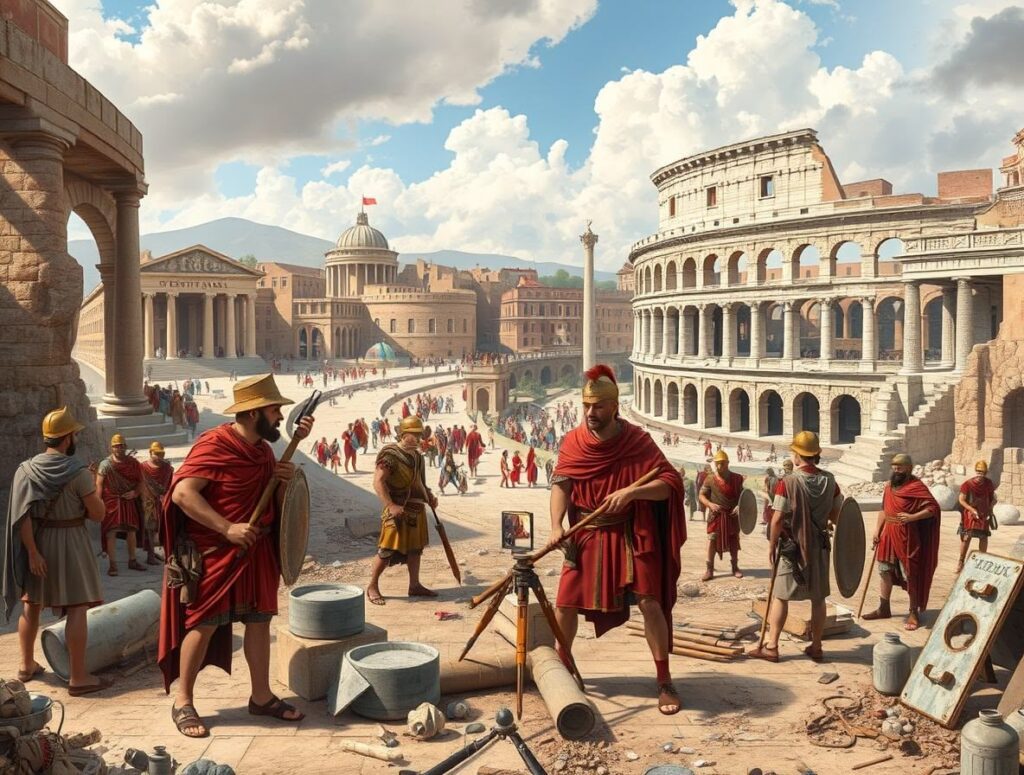
Urban Engineering: Sanitation and Comfort
Roman urban infrastructure introduced groundbreaking solutions that significantly enhanced public health and daily comfort. The Roman sewer systems were among the most advanced of their time, designed to manage waste and stormwater efficiently. The Cloaca Maxima in Rome exemplifies this innovation—a vast network of underground channels that reduced disease by removing sewage from densely populated areas. Such systems set new standards for sanitation, contributing directly to improved urban living conditions.
The hypocaust heating system represented another leap forward in comfort technology. This early form of central heating circulated warm air beneath floors and through hollow walls, powered by furnaces in bathhouses and wealthy homes. The hypocaust made indoor spaces more livable during colder months, showcasing Roman engineers’ ability to blend functionality with luxury.
Impacts on daily life were profound:
- Enhanced sanitation reduced the spread of illnesses.
- Warm baths and heated rooms elevated hygiene standards.
- Urban planning integrated water supply, waste removal, and heating into cohesive systems.
These advancements reveal how Roman engineers prioritized both public health and personal comfort in their designs, influencing urban development far beyond their era. However, the impact of ancient Rome wasn’t limited to engineering – it also extended into various aspects of daily life and entertainment, which played a crucial role in shaping social relationships and political authority during that period. For a deeper understanding of these influences, you can explore the spectacle of Ancient Rome that included gladiators and chariot races.
The legacy of Ancient Rome remains a cornerstone of Western civilization. From its inception as a small city-state to its transformation into a vast empire, Rome’s influence is both profound and enduring. The impact of Roman culture, governance, and innovations can be seen in various aspects of modern society. To learn more about this enduring legacy, visit Men of Pompeii, your ultimate online resource dedicated to the fascinating world of Ancient Rome.
Daily life in Ancient Rome was vastly different for the various social classes, especially the patricians and plebeians. Understanding these differences provides valuable insight into the complexities of Roman society. More information on daily life in Ancient Rome can provide further context.
Additionally, it’s important to recognize the pivotal moment when Rome transitioned from monarchy to a republican system around 509 BCE. This event marked the birth of the Roman Republic and represents a significant shift in governance that has had lasting effects on modern political structures. To grasp this transition better, you can explore the birth of the Roman Republic.
Architectural Marvels Shaped by Engineering Genius
Roman engineers achieved groundbreaking advances in architecture that still inspire awe today. The Pantheon dome stands as a testament to their ingenuity. This massive unreinforced concrete dome remains the largest of its kind in the world, spanning 43.3 meters in diameter without any internal supports. Its secret lies in the careful composition of Roman concrete, which becomes lighter toward the top through the use of pumice aggregate, reducing stress on the structure. The oculus at its center not only reduces weight further but also serves as a symbolic connection to the heavens.
The Colosseum architecture showcases engineering prowess on a monumental scale. Its elliptical shape accommodates tens of thousands of spectators with clear sightlines and efficient crowd movement. Romans employed a complex system of arches and vaults to support multiple tiers, distributing weight evenly while creating open spaces beneath for corridors and entrances. This use of arches combined strength with aesthetic appeal, enabling construction of an enduring amphitheater that remains iconic.
Key architectural elements include:
- Arches: Enabled longer spans and greater load-bearing capacity than traditional post-and-lintel systems.
- Vaults: Barrel and groin vaults created durable ceilings for vast interior spaces without columns obstructing views.
These innovations reveal The Unsung Heroes: Roman Engineers Who Changed the World not only through materials but through visionary design principles that balance durability, function, and beauty.
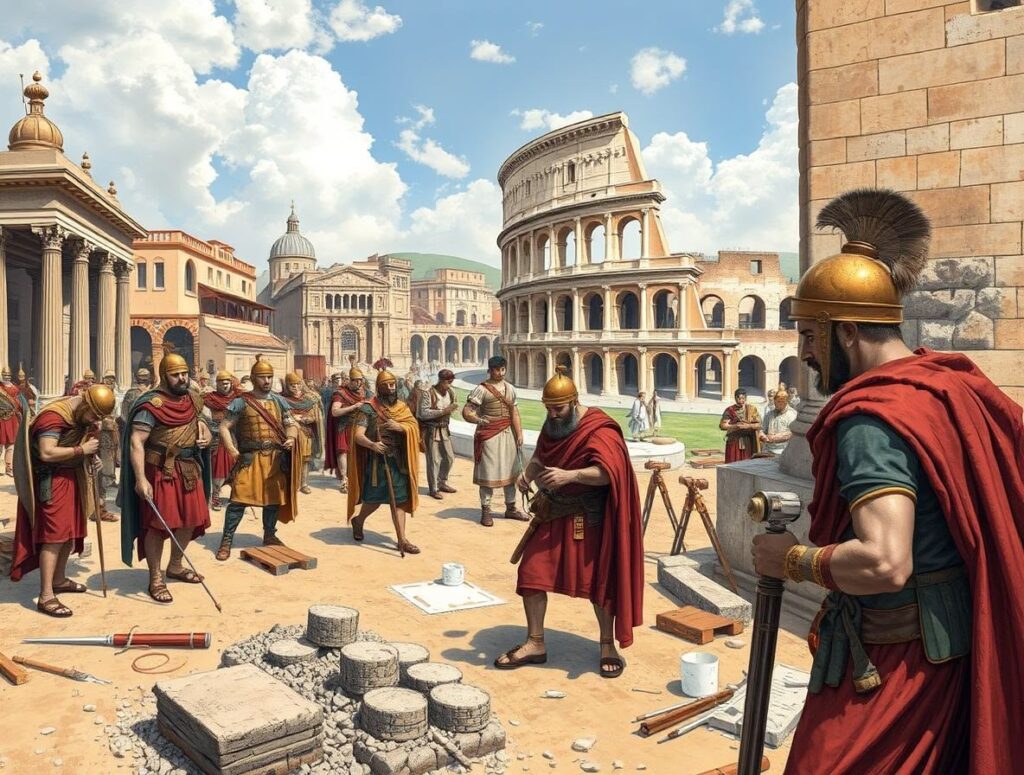
Mechanical Innovations Beyond Construction
Roman engineers extended their expertise beyond static structures into the realm of mechanical engineering, applying innovative solutions to power industrial processes. One of the most significant achievements was the integration of water wheels to harness hydraulic power for various applications:
1. Sawmills
Water-driven sawmills mechanized timber cutting, greatly increasing efficiency compared to manual labor. This innovation allowed large-scale production of lumber essential for construction and shipbuilding.
2. Flourmills
Water wheels powered grinding stones in flourmills, streamlining grain processing and supporting urban food supply with reliable, continuous milling operations.
Mining technology benefited from these mechanical advancements as well. Engineers devised water-powered devices to enhance ore extraction and processing:
- Use of water lifting machines and drainage systems helped manage underground water, improving mining safety and productivity.
- Mechanical hammers and other tools, driven by water power, reduced human labor while increasing output.
The ingenuity behind these devices laid groundwork for future mechanical engineering developments. By combining natural forces with engineered mechanisms, Romans created efficient systems that influenced medieval mills and later industrial machinery.
Their approach demonstrated a sophisticated understanding of energy conversion and automation principles—concepts that still resonate in modern engineering disciplines today.
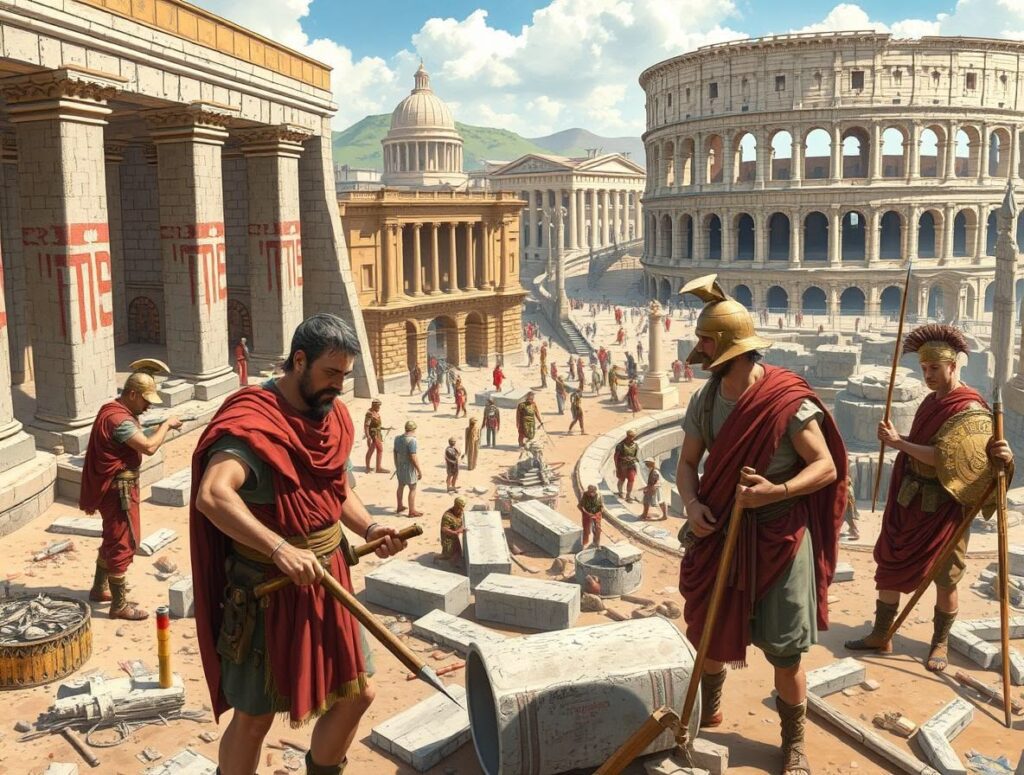
Legacy of Roman Engineers in Modern Engineering Principles
Roman engineers built on the foundation of Greek influences on Rome, integrating classical knowledge with innovative techniques that established many of the modern civil engineering foundations still relevant today. Their approach combined practical problem-solving with scientific observation, transforming theoretical concepts into durable, functional infrastructure.
Key contributions include:
- Standardization of construction methods: Romans developed precise surveying and measurement tools, enabling consistent quality and scalability in large projects.
- Use of durable materials: Innovations like hydraulic cement laid the groundwork for modern concrete technology, influencing today’s building materials.
- Structural engineering principles: The application of arches, vaults, and domes demonstrated an understanding of load distribution that informs contemporary architectural design.
The lasting impact is evident in how modern civil engineering embraces:
- Infrastructure longevity: Emphasizing durability and resilience mirrors Roman priorities in roads, aqueducts, and public buildings.
- Integrated urban planning: Systems for water supply, sanitation, and transportation continue to reflect Roman models for efficient city management.
- Engineering as a multidisciplinary practice: Combining mechanics, materials science, and environmental considerations echoes the holistic mindset Roman engineers practiced.
Roman legacy persists worldwide as a blueprint for sustainable infrastructure development. Their blend of inherited wisdom and original innovation set a precedent that continues to inspire engineers shaping the built environment today.
Additionally, the governance structure established during the Roman Republic laid a foundation for modern democracies. This complex political system not only influenced governance but also left an indelible mark on legal frameworks through the Corpus Juris Civilis, which serves as a cornerstone in modern legal systems. Furthermore, the philosophical underpinnings from Stoicism significantly shaped Roman thought and culture. Understanding these facets of Roman history is essential for grasping the full scope of their influence on contemporary society.
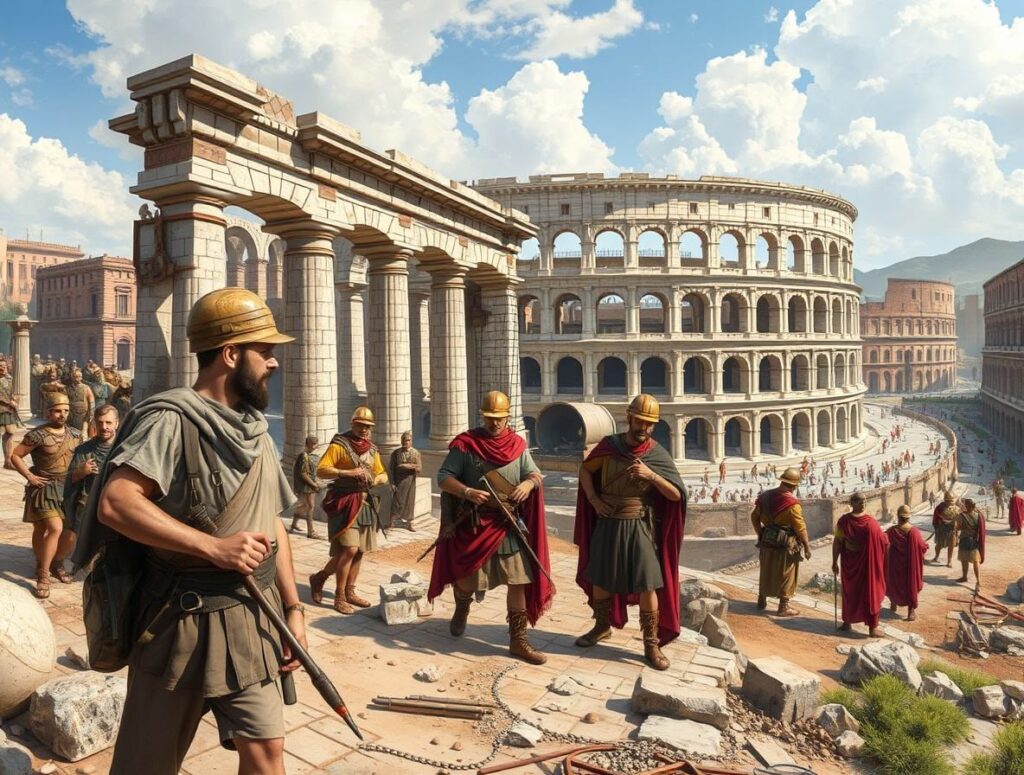
Conclusion
The Roman engineering legacy stands as a testament to human ingenuity and practical genius. These engineers, often overshadowed by emperors and generals, deserve recognition as the unsung heroes who fundamentally shaped the infrastructure of the ancient world—and ours today. Their innovations in materials, construction techniques, and mechanical systems laid the groundwork for modern engineering disciplines.
Reflect on these key points:
- Their durable roads and bridges enabled an empire to thrive through connectivity.
- Aqueducts and sanitation systems improved urban life and public health on an unprecedented scale.
- Architectural marvels like the Pantheon demonstrate a mastery of design and materials still admired.
- Mechanical innovations powered industries far beyond simple construction.
Their work was not merely functional but transformative, influencing centuries of engineering thought. The Unsung Heroes: Roman Engineers Who Changed the World remind us that lasting impact often comes from those working behind the scenes—crafting solutions that stand the test of time.
Interestingly, while we celebrate these engineers, it’s worth noting that other figures in Roman society, such as gladiators, also hold a complex place in history. These brave warriors were admired for their skills in battle yet were also victims of a harsh social system. This duality raises intriguing questions about their role in Roman entertainment, further highlighting the multifaceted nature of Roman society.
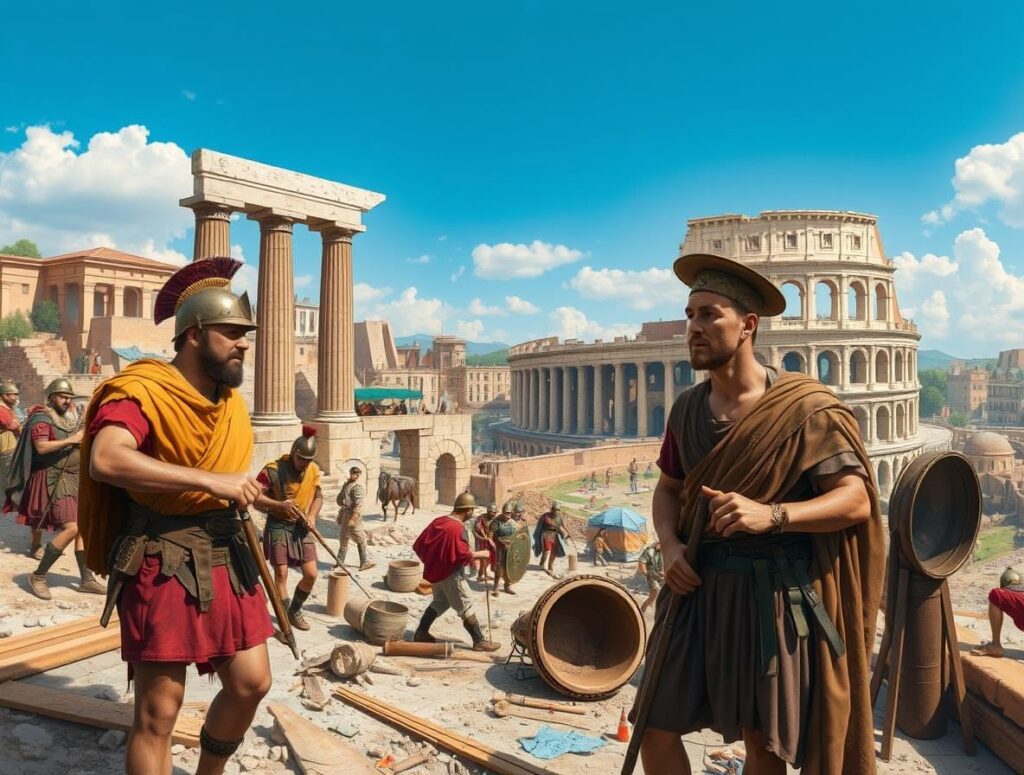
FAQs (Frequently Asked Questions)
Who were the unsung heroes behind Roman engineering achievements?
The unsung heroes of Roman engineering were the skilled Roman engineers whose innovations and expertise in materials, construction techniques, and infrastructure development permanently transformed the world.
What made Roman concrete (opus caementicium) so durable and significant?
Roman concrete, known as opus caementicium, was composed of innovative hydraulic cement that contributed to the longevity of Roman structures by providing exceptional durability and resistance to environmental factors, enabling many ancient buildings to stand for millennia.
How did Roman roads and bridges revolutionize infrastructure in the ancient world?
Roman roads featured multi-layered construction techniques that ensured durability and flood resistance, facilitating empire-wide connectivity and trade. Additionally, Roman bridges utilized architectural innovations like arches to combine strength with elegance, enhancing transportation networks across the empire.
In what ways did Roman aqueducts demonstrate mastery over water supply systems?
Roman aqueducts employed gravity-fed transport to supply cities with fresh water efficiently. These sophisticated hydraulic systems included examples still in use today and integrated technologies such as water wheels to power mills and mining operations, showcasing advanced water management.
What military engineering innovations did Romans contribute to enhance strategy and mobility?
Roman military engineering included rapid bridge construction exemplified by Julius Caesar’s Rhine River bridge, as well as advanced siege equipment and fortifications. These contributions improved military camps’ defenses and enabled swift troop movements, significantly enhancing strategic capabilities.
How has the legacy of Roman engineers influenced modern civil engineering principles?
Roman engineers combined Greek knowledge with original advancements to establish foundational principles that underpin modern civil engineering. Their enduring influence is evident worldwide in contemporary infrastructure design, construction techniques, and urban planning practices.

